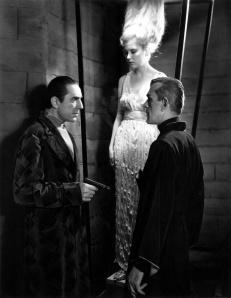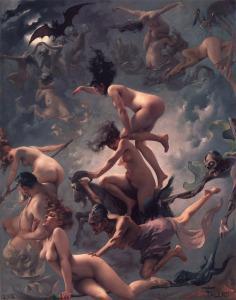This essay first appeared in Cliterati on October 12th; I have modified it slightly to fit the format of this blog.
 As befits a girl who was born on Halloween night, I’m a big fan of horror films, horror stories, horror TV shows, horror comics, horror poems and just about anything macabre and creepy. I’ve written about horror fiction on my blog more than a few times, especially (though by no means exclusively) in October, which is my favorite month in part because it’s Halloween season. But this is not merely a deviation from my usual topic; in fact, as I explained in “Eros and Phobos”, fear and sex are inextricably intertwined:
As befits a girl who was born on Halloween night, I’m a big fan of horror films, horror stories, horror TV shows, horror comics, horror poems and just about anything macabre and creepy. I’ve written about horror fiction on my blog more than a few times, especially (though by no means exclusively) in October, which is my favorite month in part because it’s Halloween season. But this is not merely a deviation from my usual topic; in fact, as I explained in “Eros and Phobos”, fear and sex are inextricably intertwined:
…the trappings of BDSM would be equally at home in a gothic horror setting, the rape fantasy is as popular as ever and the lurid fantasies of “sex trafficking” fetishists can be found in mainstream news outlets every day, forced up from the collective unconscious by the pressure of the return to Victorian levels of prudery. Nor does one always have to look outward to find the connection; I’m sure many of my readers have realized that the things that sexually excite them most are often related to things that frighten them. For example, some of you may recall my mentioning that I have a phobia of being trapped (including in traffic jams), and I think even the veriest psychological amateur could recognize that I have a tremendous aversion to authority. Yet at the same time, I’m turned on by bondage and themes of dominance and submission…
I hardly think it’s necessary to point out that when an individual tries to suppress sexual desires, they usually pop out somewhere else; the same thing is true of society as a whole. The neo-Victorians who now dominate our culture are so afraid of sex they’re trying to completely neuter and domesticate it:
They imagine that engaging in sex for the “wrong” reasons, or without the benediction of elaborate rituals of consent, or with people separated from one another by more than a very few years of age, is terribly harmful. They believe that merely taking pictures of the taboo act creates a kind of Gorgonic icon which drives its viewers mad, and that the mere existence of such images harms women and children who are not even in close proximity to it. And they fervently assert that it is so incredibly dangerous to the sacred “innocence” of “children” (a term which refers not to true children, but to a ritual category which actually includes some adults), for strangers to even imagine sexual contact with them causes such tremendous harm that those who indulge in these Forbidden Thoughts deserve penalties greater than those for violent assault, followed by lifelong social ostracism…
But this only results in the suppressed desires popping out somewhere else. As I explained in “Eros and Phobos”, horror fiction is one of those points of eruption; it’s a “safe” way to way to deal with feelings that one is afraid to admit to, a way to separate the taboo “dirty”, “bad”, violent or otherwise forbidden aspects of sex from wedding-cake images of romantic love and Utopian talk of mutual pleasure and “enthusiastic consent”. The more rigid the social demands for 100% clear, legally-provable consent, the more rape fantasies we should expect to see. The more society insists that the only acceptable sex is between age-peers, the more Lolita imagery will appear. The more loudly “thought leaders” insist that love and mutual pleasure are the only acceptable reasons for sex, the more attention will be paid to whores. And the more fixated conformists are on marriage and monogamy, the higher the number of clients the harlots strolling down the streets of their imaginations must have.
 Given the draconian sexual regime our increasingly-repressive culture has imposed by use of both violence and shame, we should expect to see a great deal of horror fiction in which very young girls are abducted, raped, enslaved as prostitutes and forced to see exorbitant numbers of men. And so we do; the lurid, sensationalized tragedy porn narratives that make up the body of “sex trafficking” mythology are nothing more than Gothic horror tales that opportunists pretend are real. But do the members of the general public actually believe these stories, or are they just outlets for psychosexual tension accepted with the same mixture of credulity and doubt with which our ancestors greeted the spooky tales told around campfires? It has been pointed out that if anyone actually believed that one in five young women on campuses were raped, nobody would ever send their daughters to coed universities; similarly, if anyone actually accepted the claim that “Young ladies are being grabbed off bus stops and forced into prostitution”, we’d be seeing a constant parade of abductees’ pictures on the news and demands for armed guards at bus stops. Perhaps one of the reasons for the popularity of such folklore is that on some level people know it isn’t real (even if they consciously deny it); just as the old tales shared certain motifs and were repeated in a ritualized fashion that branded them as fabulous, so do these modern legends. Perhaps the “sex trafficking” hysteria is at its heart nothing more than a succession of horror plays, sequels to (or remakes of) those in the very popular “Satanic Panic” series of the 1980s and ‘90s, and like them serving as “safe” outlets for anxieties caused by the onerous puritanism of modern Anglo-American culture. “Safe”, that is, for the audience; in this horror drama the actors, unlike those in Hammer films or Grand Guignol theater, are both involuntary and unpaid. And as long as this panic goes on they will be forced, like the imaginary sex slaves of the narrative, to play out the scripts drawn from their captors’ twisted psyches at the cost of their own freedom, happiness and lives.
Given the draconian sexual regime our increasingly-repressive culture has imposed by use of both violence and shame, we should expect to see a great deal of horror fiction in which very young girls are abducted, raped, enslaved as prostitutes and forced to see exorbitant numbers of men. And so we do; the lurid, sensationalized tragedy porn narratives that make up the body of “sex trafficking” mythology are nothing more than Gothic horror tales that opportunists pretend are real. But do the members of the general public actually believe these stories, or are they just outlets for psychosexual tension accepted with the same mixture of credulity and doubt with which our ancestors greeted the spooky tales told around campfires? It has been pointed out that if anyone actually believed that one in five young women on campuses were raped, nobody would ever send their daughters to coed universities; similarly, if anyone actually accepted the claim that “Young ladies are being grabbed off bus stops and forced into prostitution”, we’d be seeing a constant parade of abductees’ pictures on the news and demands for armed guards at bus stops. Perhaps one of the reasons for the popularity of such folklore is that on some level people know it isn’t real (even if they consciously deny it); just as the old tales shared certain motifs and were repeated in a ritualized fashion that branded them as fabulous, so do these modern legends. Perhaps the “sex trafficking” hysteria is at its heart nothing more than a succession of horror plays, sequels to (or remakes of) those in the very popular “Satanic Panic” series of the 1980s and ‘90s, and like them serving as “safe” outlets for anxieties caused by the onerous puritanism of modern Anglo-American culture. “Safe”, that is, for the audience; in this horror drama the actors, unlike those in Hammer films or Grand Guignol theater, are both involuntary and unpaid. And as long as this panic goes on they will be forced, like the imaginary sex slaves of the narrative, to play out the scripts drawn from their captors’ twisted psyches at the cost of their own freedom, happiness and lives.
